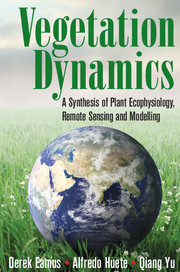Book contents
- Frontmatter
- Contents
- Preface
- Section One Plant Ecophysiology
- 1 An Introduction to Biogeography: Broad-Scale Relationships Amongst Climate, Vegetation Distribution and Vegetation Attributes
- 2 An Introduction to Plant Structure and Ecophysiology
- 3 Water Relations, Hydraulic Architecture and Transpiration by Plants
- Section Two Remote Sensing
- Section Three Modelling
- Section Four Case Studies
- Index
- References
1 - An Introduction to Biogeography: Broad-Scale Relationships Amongst Climate, Vegetation Distribution and Vegetation Attributes
from Section One - Plant Ecophysiology
Published online by Cambridge University Press: 05 June 2016
- Frontmatter
- Contents
- Preface
- Section One Plant Ecophysiology
- 1 An Introduction to Biogeography: Broad-Scale Relationships Amongst Climate, Vegetation Distribution and Vegetation Attributes
- 2 An Introduction to Plant Structure and Ecophysiology
- 3 Water Relations, Hydraulic Architecture and Transpiration by Plants
- Section Two Remote Sensing
- Section Three Modelling
- Section Four Case Studies
- Index
- References
Summary
This chapter provides a broad-scale overview of the patterns of global distribution of rainfall, temperature and evaporative demand. In addition it provides an introduction to some of the causes of inter-annual variability (including the El Niño Southern Oscillation, the North Atlantic Oscillation and the Southern Annular Mode) in weather patterns. Examination of the impacts of inter-annual variability of rainfall and temperature is a recurrent theme in studies of vegetation ecophysiology, modelling of landscape function and the application of remote sensing to investigate landscape structure and function. This chapter describes how climate variables were originally used to classify vegetation assemblages into biomes but also discusses the concept of plant functional types and shows how these are increasingly used in the disciplines of modelling and remote sensing as a means of representing biomes. Finally, leaf and whole-plant attributes that are deemed important in land surface models and remote sensing are discussed and recent developments in the interpretation of plant functional types are presented.
Large-Scale Patterns in Climate
The Solar Constant and the Earth's Tilt
Directly above the equator, at noon, about 1367 watts of solar energy per square metre (1367 W m−2) are received at the outer edge of the atmosphere. This is termed the solar constant, although the sun's output is not constant with time because of changes in solar activity, including the 11-year sunspot cycle. About 7 percent of solar radiation is ultraviolet, about 41 percent is in the visible range (0.4–0.7 μm) and 51 percent has a wavelength > 0.7 μm (near infrared). The global annual average receipt of solar radiation at the edge of the atmosphere is, however, about 342 W m−2, that is, one quarter of the solar constant. This is because the surface area of a sphere (assuming the earth is a sphere) is four times larger than the surface area of a disc of the same radius and thus solar energy is spread across an area four times larger than if the earth were a simple flat disc.
- Type
- Chapter
- Information
- Vegetation DynamicsA Synthesis of Plant Ecophysiology, Remote Sensing and Modelling, pp. 3 - 42Publisher: Cambridge University PressPrint publication year: 2016



